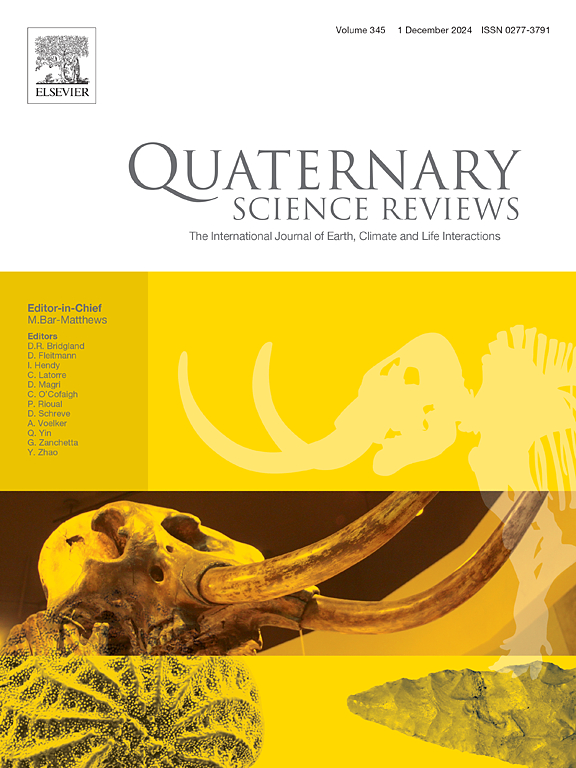Palaeoenvironmental reconstruction of a fjord catchment NW Scotland, UK since the Last Glacial Maximum: A multi-geochemical approach
IF 3.2
1区 地球科学
Q1 GEOGRAPHY, PHYSICAL
引用次数: 0
Abstract
Loch Sunart, a fjord in NW Scotland, UK, records Late Glacial to Holocene sedimentation preserving palaeoenvironmental changes associated with the deglaciation of the British-Irish Ice Sheet (BIIS). This study combines a multi-proxy approach (osmium isotope analysis, carbon, sulphur and nitrogen elemental and isotopic analysis together with X-ray fluorescence, alkenone biomarkers and benthic foraminifera) to contribute to our understanding of the regional nature of BIIS deglaciation and enable the reconstruction of palaeoclimate variations since the last glacial. The observed patterns in the applied proxies collectively suggest that between ∼18 and 12.9 cal ka BP as the BIIS retreated, Loch Sunart experienced increased glacial meltwater discharge. Throughout this period, 187Os/188Os values are more radiogenic than the contemporaneous open ocean waters (∼1.04–1.06), which are interpreted to reflect an increase in glacially eroded sediment flux directly associated with glacial retreat following the Last Glacial Maximum. During the Younger Dryas, the fjord experienced a pause in glacially derived sediment reflected by a minimum in 187Os/188Os (∼1.1), which was followed by an increase in 187Os/188Os to more radiogenic values (∼1.3) at the end of the Younger Dryas. Coincident with changes in 187Os/188Os values, alkenone-based %C37:4 values increase (40–60%), δ13Corg values decrease (−24‰) and foraminifera species indicative of restricted water renewal increased in abundance, suggesting a period of water stratification. A rapid shift in 187Os/188Os values toward a marine signature of ∼1 indicates that the basin experienced a breakdown in water stratification and renewed mixing from 5 cal ka BP. This interpretation is further supported by a coincident decrease in %C37:4 to <15%, and by distinct increases in wt% C, wt% N and δ13Corg. This multi-proxy approach, specifically integrating Os, provides additional insight to the BIIS in NW Scotland, in particular how such fjords can respond to glacial readvance during the Younger Dryas, which was not captured by previous studies.
末次盛冰期以来英国苏格兰西北部峡湾集水区的古环境重建:一种多地球化学方法
苏纳特湖是英国苏格兰西北部的一个峡湾,记录了晚冰期到全新世的沉积,保存了与英国-爱尔兰冰盖(BIIS)脱冰有关的古环境变化。本研究结合了多代理方法(锇同位素分析、碳、硫、氮元素和同位素分析以及x射线荧光、烯酮生物标志物和底栖有孔虫),有助于我们了解BIIS脱冰的区域性质,并使末次冰期以来的古气候变化得以重建。应用代用物的观测模式共同表明,在~ 18 ~ 12.9 cal ka BP之间,随着BIIS的退缩,苏纳特湖经历了冰川融水流量的增加。在整个这一时期,187Os/188Os值比同时期的公海(~ 1.04-1.06)更具有放射性,这被解释为反映了末次盛冰期后冰川退缩直接导致的冰川侵蚀沉积物通量的增加。在新仙女木时期,峡湾经历了冰川沉积的暂停,反映在187Os/188Os的最小值(~ 1.1),随后在新仙女木期结束时,187Os/188Os增加到更多的放射成因值(~ 1.3)。与187Os/188Os值的变化一致,以烯酮为基础的%C37:4值增加(40 ~ 60%),δ13Corg值减少(−24‰),指示有限水体更新的有孔虫种类增加,表明水体分层时期。187Os/188Os值向海洋特征的~ 1的快速转变表明,盆地从5 cal ka BP开始经历了水分层的破裂和重新混合。这一解释进一步得到了%C37:4下降到<;15%,以及wt% C、wt% N和δ13Corg明显增加的支持。这种多代理方法,特别是整合o,为苏格兰西北部的BIIS提供了额外的见解,特别是这些峡湾如何响应新仙女木时期的冰川推进,这是以前的研究没有捕捉到的。
本文章由计算机程序翻译,如有差异,请以英文原文为准。
求助全文
约1分钟内获得全文
求助全文
来源期刊

Quaternary Science Reviews
地学-地球科学综合
CiteScore
7.50
自引率
15.00%
发文量
388
审稿时长
3 months
期刊介绍:
Quaternary Science Reviews caters for all aspects of Quaternary science, and includes, for example, geology, geomorphology, geography, archaeology, soil science, palaeobotany, palaeontology, palaeoclimatology and the full range of applicable dating methods. The dividing line between what constitutes the review paper and one which contains new original data is not easy to establish, so QSR also publishes papers with new data especially if these perform a review function. All the Quaternary sciences are changing rapidly and subject to re-evaluation as the pace of discovery quickens; thus the diverse but comprehensive role of Quaternary Science Reviews keeps readers abreast of the wider issues relating to new developments in the field.
 求助内容:
求助内容: 应助结果提醒方式:
应助结果提醒方式:


